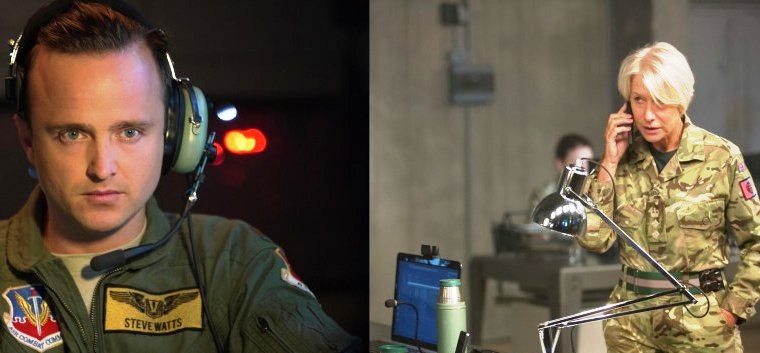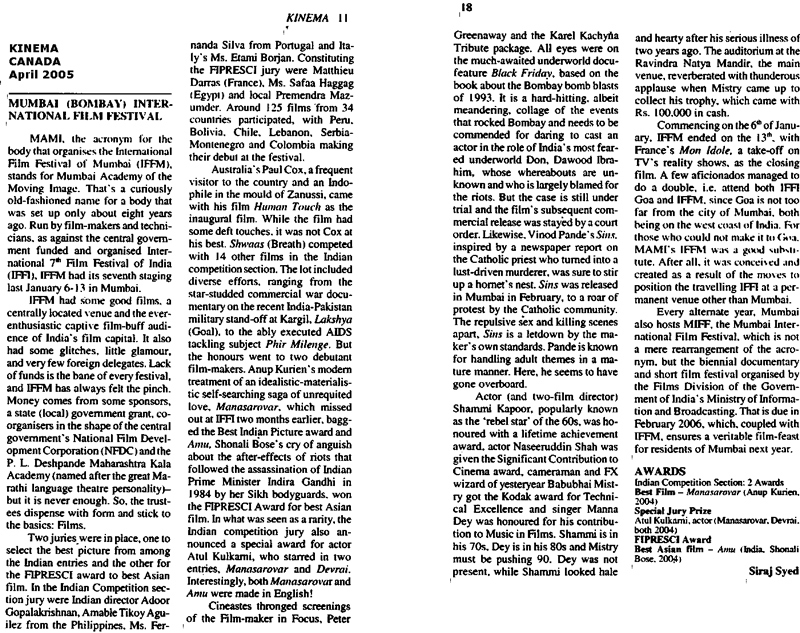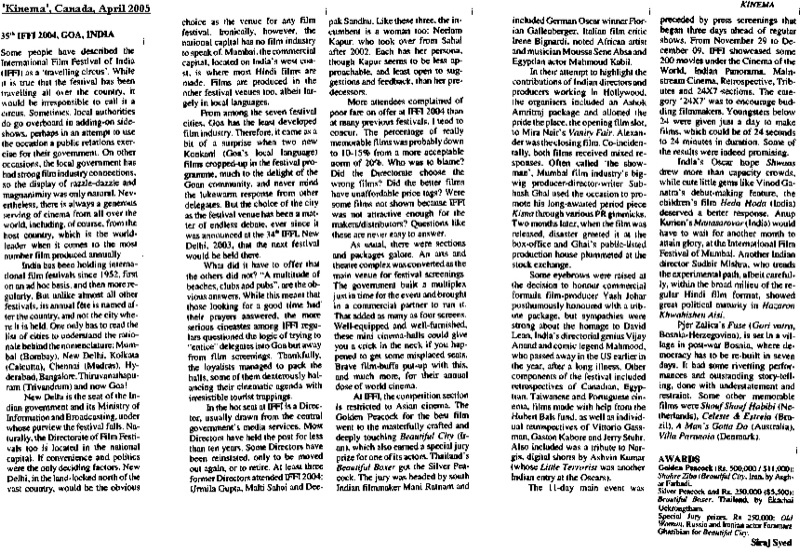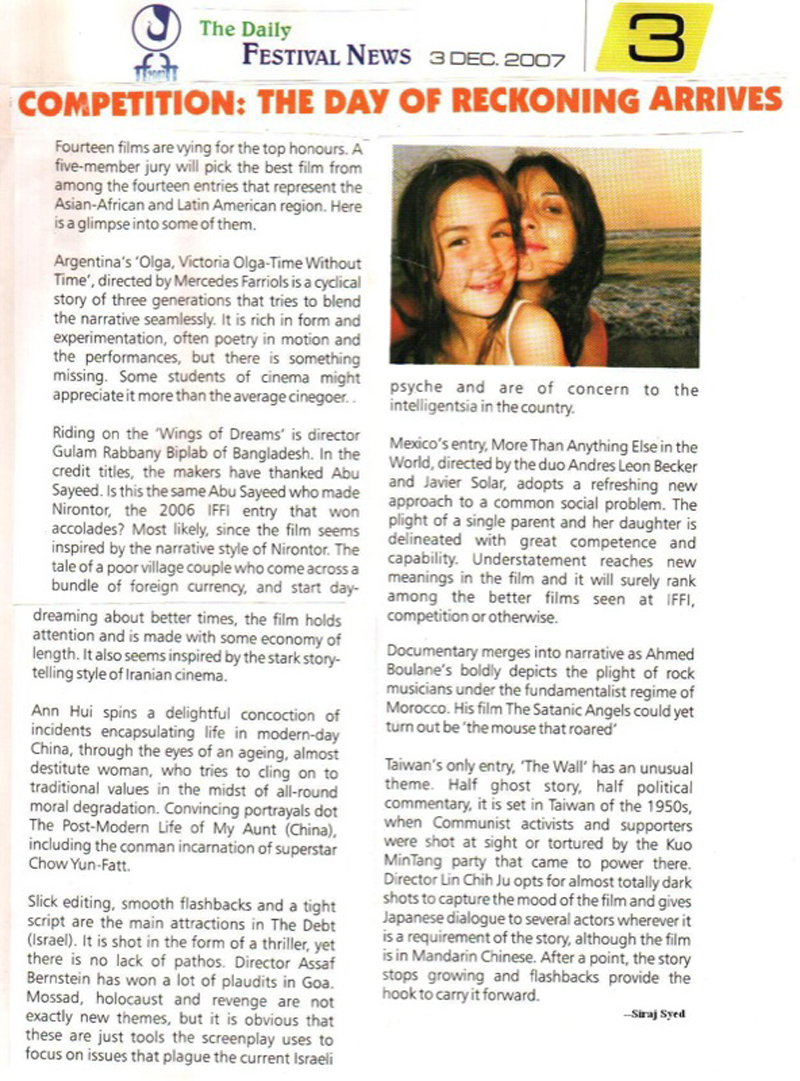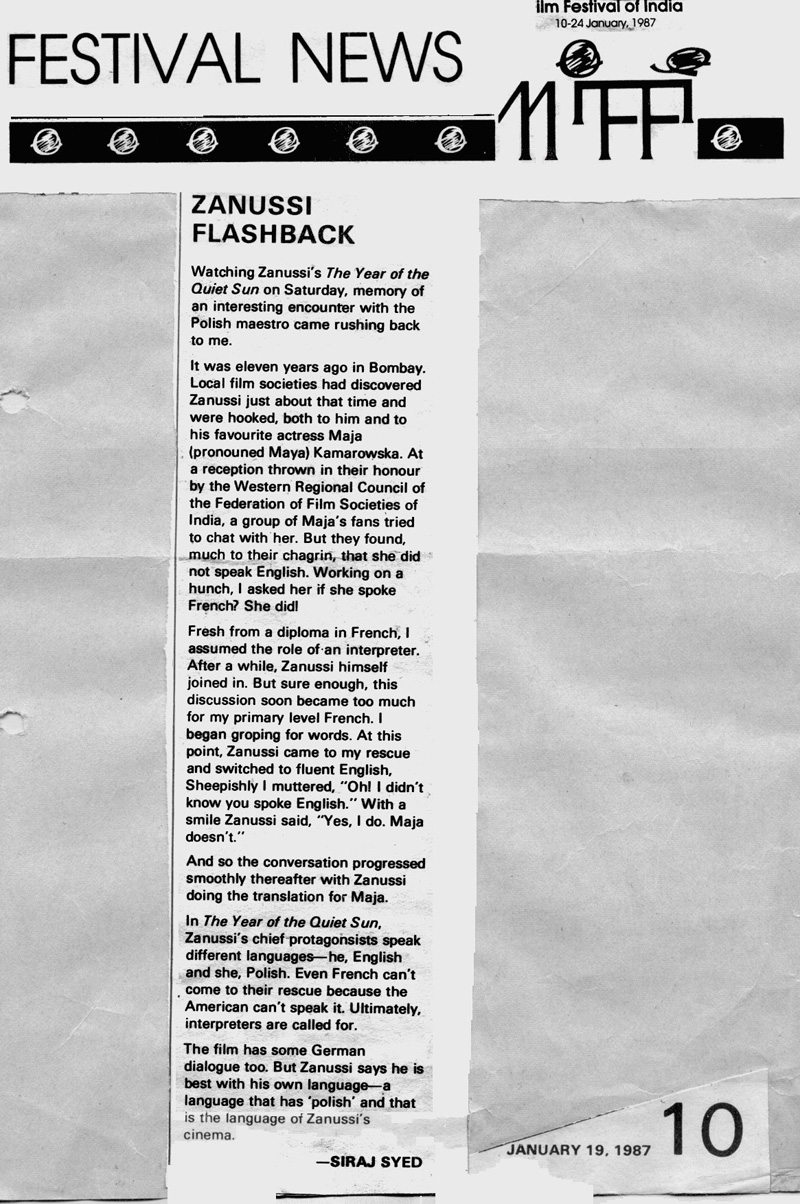|
|
||
|
Pro Tools
FILMFESTIVALS | 24/7 world wide coverageWelcome ! Enjoy the best of both worlds: Film & Festival News, exploring the best of the film festivals community. Launched in 1995, relentlessly connecting films to festivals, documenting and promoting festivals worldwide. Sorry for the disruptions we are working on the platform as of today. For collaboration, editorial contributions, or publicity, please send us an email here. User loginActive Members |
Siraj SyedSiraj Syed is the India Correspondent for FilmFestivals.com and a member of FIPRESCI, the International Federation of Film Critics. He is a Film Festival Correspondent since 1976, Film-critic since 1969 and a Feature-writer since 1970. He is also an acting and dialogue coach. @SirajHSyed  Eye in the Sky, Review: Mor(t)al blows
Eye in the Sky, Review: Mor(t)al blows Collateral damage has been an emotion charged topic for debates world-wide, ever since the USA began bombing foreign locations, where, it believed, wanted persons were living, hiding or gathering. Along with its allies, notably the UK, the USA has been carrying out pre-emptive air-strikes for decades. Eye in the Sky (the title does not do full justice to its theme and thrust) is about the compunction experienced by a group of high-placed government officials and military personnel who hesitate before they sanction a drone strike; others, who strongly feel that this procrastination is unwarranted; and still others, who need to hear strong arguments from both camps, before deciding aye or nay. The film is not a new subject, it is not an eye-opener, nor is the ‘take’ new. Occasionally masquerading as a spy satire, Eye in the Sky is definitely compelling viewing, an emotional volcano, and a political see-saw. A family of Somali refugees lives next door to Al-Shabab terrorists in a Nairobi slum. Their only child, a nine year-old daughter, Alia (Aisha Takow) of a bicycle repairman Musa Mo'Allim (Armaan Haggio) sells her mother Fatima (Faisa Hassan)’s home-baked bread at a table right outside a safe-house. American, British, and Kenyan intelligence teams have tracked two British nationals, one black US national whose British wife, Susan Helen Danford (Lex King), now known as Ayesha Al Hady, helped recruit two suicide bombers. The two are being initiated inside that very house. Tracking them on ground is agent Jama Farah (Barkhad Abdi), using the latest, most sophisticated gadgets, like a remote controlled bird camera and a tiny, beetle-like device, called Ringo. Colonel Katherine Powell (Helen Mirren), a UK-based military officer, has been following Danford, a converted, radicalised woman, for six years. Powell discovers the suicide bombing plan and the mission escalates from "capture" to "kill." The presence of UK and US citizens, albeit rogue elements, and the location being a friendly country, are debated, and overridden. But as American pilot Steve Watts (Aaron Paul) and his colleague Carrie Gershon (Phoebe Fox) are about to engage the ‘eye in the sky’ to shoot a Hellfire missile, Alia enters the ‘kill zone’, triggering an international re-assessment of the situation, at the highest levels of the US and British governments: British Lieutenant General (Alan Rickman), British Foreign Secretary (Iain Glen), British Attorney General (Richard McCabe), Angela Northam (Monica Dolan) and another, similar contingent across the Atlantic. The moral, political, and personal implications of the ‘to bomb or not to bomb’ situation are dissected and analysed, with stands softening and hardening, until the inevitable. Guy Hibbert (Five Minutes of Heaven, Omagh, Prime Suspect) has written the screenplay, and in the absence of any other writing credit, we assume that it is an original work. A reference to American Sniper is too apparent to ignore, if you recall the woman and boy whom Bradley Cooper hesitates to shoot in the Jason Hall written and Clint Eastwood directed moral tale. Numerous other news items (see two culled, below) about various USA/NATO/Allied forces/friendly country operations must have surely turned-up in Hibbert’s searches, who has churned them all into an engaging blend. He keeps melodrama to a minimum, making it even more potent, but the ping-pong game (used as a telling metaphor in the film) does tend to get predictable, even funny, when each player wants to ‘refer-up’, to his/her superiors. How and when that reference happens is, to his credit, imaginatively, even humorously woven-in. (I confess that I liked the familiar sight of Singapore’s Marina Bay Sands hotel, but I must also confess that an arms dealers’ convention is not a serene sight, wherever it is held). A double whammy climax, in the mould of a Charlie Chaplin tragic-comic punch, adds to the narrative. Director Gavin Hood (Tsotsi, Rendition X-Men Origins: Wolverine, Ender's Game) was born in South Africa, drafted at 17 and sent to Angola to fight. He lost a close friend there and returned a very different person. A military reservist, he decided not to participate in the proxy wars any more, and moved to the United States in 1989, to study film-making. Eye in the Sky is shot in his native country, where he was not allowed the use of real drones, so VFX have been used instead. Eye in the Sky (drone bomber) apart, three other devices are very much James Bondish, ‘Q’ey creations: the bird, the cigarette case and the beetle. For obvious reasons, his delving into the black characters, even those that are on the UK-USA side, is a shade deeper than the portrayal of the white war-room brains, and the concerned higher-ups elsewhere. That is not to say that almost all the white actors don’t give us immersed cameos. It is unclear why the spy camera coverage of the goings on inside the ‘safe-house’ is incorporated in slow, boringly repetitive, documentary style, notwithstanding the ritual, and the one explosive discovery as it moves into an adjoining room. Hood chooses not to translate or sub-title the dialogue in the African languages, indirectly dragging you even deeper into what is being conveyed. What you decode visually is much less than what was said, but just enough to apprise you of the operative part of the conversations. They could not but dedicate the film to Rickman, who died of pancreatic cancer in January 2016. British actor Alan Rickman (Harry Potter x 7, Die Hard, Robin Hood: Prince of Thieves), is seen in his last acting role. He will be remembered as much for his forceful persona in the war-room, as he will be for his scenes involving a doll. Helen Mirren (Excalibur, The Cook, the Thief, His Wife & Her Lover, The Queen) as a woman who has hardened her exterior, and most of her interior, to a professional level, is crisp and quietly menacing. Mirren worked with Rickman only once earlier, as Cleopatra to his Antony, in the stage production of Shakespeare’s play, in 1998, and had this to say about the memory, “It was difficult because he stepped in at the last minute when the actor who was originally playing the role dropped out. . . . He came in and very courageously jumped in.” In Eye in the Sky, the two actors did not end up sharing any scenes at all, because they were at different locales, and were communicating via video links—a point, Mirren said, “I’m very, very upset about.” Barkhad Abdi (Somali-American former limo cab driver/DJ, Oscar nominee for Captain Phillips-2013) is strikingly gifted. This is a completely convincing and natural performance. Aaron Paul (Triple 9, Exodus: Gods and Kings, Need for Speed)’s conscience is for all to empathise with, with helpless sympathy coming from debutante Phoebe Fox (theatre, TV, first major role). Babou Ceesay as Sergeant Mushtaq Saddiq, who is diplomatically blackmailed into fudging Collateral Damage Estimates (CDE), internalises and ‘cottonises’ the proverbial sledge-hammer moral blow he receives, to perfection. The second, longish scene featuring him and Mirren haunts you for long. Iain Glen (Jack Taylor, Breathless, The Iron Lady) makes a suitable Foreign Secretary, just as Richard McCabe and Monica Dolan slip into their parts. Ed Suter as Benson’s ADC adds the touch of a very British smile. Lex King has no part, to speak of. Faisa Hassan, Arman Haggio and Aisha Takow could not have been better cast. Try and hold back your tears as they swirl and well up to the looping hula hoop of Aisha Takow. Rating: ***1/2 Trailer: https://www.youtube.com/watch?v=TowybOAURIw Al-Shabab denies top leaders killed in US air strikes (Source: Al Jazeera) Senior commander makes public appearance to deny claims he and another leader were killed in raids in southern Somalia. Hamza Mohamed | 10 Mar 2016 17:57 GMT | Somalia, Al-Shabab, Africa, War & Conflict Mogadishu, Somalia - A senior al-Shabab commander has made a public appearance to deny claims that he and another group leader were killed in US air strikes last week at a training camp in southern Somalia. Washington said on Monday it had carried out several strikes in Somalia's Hiiraan region, in which it claimed more than 150 of the al-Qaeda-linked group's fighters had been killed. Somali officials said later on Monday that five al-Shabab commanders had been killed in Saturday's attack, including Mohamed Mire, the group's Hiiraan governor, and Yusuf Ali Ugas, al-Shabab's former Hiiraan chief. But Mire appeared on Thursday in the village of Buqa Qabe - in the same province the air strikes took place - to dismiss the claims. "It is all lies. They said I was among those killed. But I'm here and doing well as you can see," he told a crowd that had gathered to see the public execution of a man the group accused of being a Somali government soldier. Al-Shabab, which is fighting Somalia's internationally recognised government, has recently attacked and overrun military bases belonging to the African Union peacekeeping mission, AMISOM. The US air strikes occurred at 14:00 GMT on Saturday at a camp about 130km from Belidogle airport in the Lower Shabelle region - a major base for AMISOM troops. American soldiers are also present at the Belidogle base. The al-Shabab fighters were training for a large-scale attack and posed an imminent threat to US and African Union forces in Somalia, according to the Pentagon. "It is all propaganda. America is losing this war and that is why they now have to resort to guerrilla tactic," Mire added, in reference to a Wednesday morning raid on the town of Awdhegle - 50km south of the capital Mogadishu - by joint US and Somali special forces. Somali officials said more than a dozen al-Shabab fighters were killed in the raid which involved two helicopters. Al-Shabab said only one of its fighters was killed. There was no way of independently verifying both claims. 41 men targeted but 1,147 people killed: US drone strikes – the facts on the ground New analysis of data conducted by human rights group Reprieve shared with the Guardian, raises questions about accuracy of intelligence guiding ‘precise’ strikes ‘Drone strikes have been sold to the American public on the claim that they’re ‘precise.’ But they are only as precise as the intelligence that feeds them.’ Spencer Ackerman in New York Monday 24 November 2014 16.55 GMT Last modified on Monday 24 November 2014 17.23 GMT The drones came for Ayman Zawahiri on 13 January 2006, hovering over a village in Pakistan called Damadola. Ten months later, they came again for the man who would become al-Qaida’s leader, this time in Bajaur. Eight years later, Zawahiri is still alive. Seventy-six children and 29 adults, according to reports after the two strikes, are not. However many Americans know who Zawahiri is, far fewer are familiar with Qari Hussain. Hussain was a deputy commander of the Pakistani Taliban, a militant group aligned with al-Qaida that trained the would-be Times Square bomber, Faisal Shahzad, before his unsuccessful 2010 attack. The drones first came for Hussain years before, on 29 January 2008. Then they came on 23 June 2009, 15 January 2010, 2 October 2010 and 7 October 2010. Finally, on 15 October 2010, Hellfire missiles fired from a Predator or Reaper drone killed Hussain, the Pakistani Taliban later confirmed. For the death of a man whom practically no American can name, the US killed 128 people, 13 of them children, none of whom it meant to harm. A new analysis of the data available to the public about drone strikes, conducted by the human-rights group Reprieve, indicates that even when operators target specific individuals – the most focused effort of what Barack Obama calls “targeted killing” – they kill vastly more people than their targets, often needing to strike multiple times. Attempts to kill 41 men resulted in the deaths of an estimated 1,147 people, as of 24 November. Reprieve, sifting through reports compiled by the Bureau of Investigative Journalism, examined cases in which specific people were targeted by drones multiple times. Their data, shared with the Guardian, raises questions about the accuracy of US intelligence guiding strikes that US officials describe using words like “clinical” and “precise.” The analysis is a partial estimate of the damage wrought by Obama’s favored weapon of war, a tool he and his administration describe as far more precise than more familiar instruments of land or air power. “Drone strikes have been sold to the American public on the claim that they’re ‘precise’. But they are only as precise as the intelligence that feeds them. There is nothing precise about intelligence that results in the deaths of 28 unknown people, including women and children, for every ‘bad guy’ the US goes after,” said Reprieve’s Jennifer Gibson, who spearheaded the group’s study. Some 24 men specifically targeted in Pakistan resulted in the death of 874 people. All were reported in the press as “killed” on multiple occasions, meaning that numerous strikes were aimed at each of them. The vast majority of those strikes were unsuccessful. An estimated 142 children were killed in the course of pursuing those 24 men, only six of whom died in the course of drone strikes that killed their intended targets. In Yemen, 17 named men were targeted multiple times. Strikes on them killed 273 people, at least seven of them children. At least four of the targets are still alive. Available data for the 41 men targeted for drone strikes across both countries indicate that each of them was reported killed multiple times. Seven of them are believed to still be alive. The status of another, Haji Omar, is unknown. Abu Ubaidah al-Masri, whom drones targeted three times, later died from natural causes, believed to be hepatitis. The data cohort is only a fraction of those killed by US drones overall. Reprieve did not focus on named targets struck only once. Neither Reprieve nor the Guardian examined the subset of drone strikes that do not target specific people: the so-called “signature strikes” that attack people based on a pattern of behavior considered suspicious, rather than intelligence tying their targets to terrorist activity. An analytically conservative Council on Foreign Relations tally assesses that 500 drone strikes outside of Iraq and Afghanistan have killed 3,674 people. As well, the data is agnostic on the validity of the named targets struck on multiple occasions being marked for death in the first place. Like all weapons, drones will inevitably miss their targets given enough chances. But the secrecy surrounding them obscures how often misses occur and the reasons for them. Even for the 33 named targets whom the drones eventually killed – successes, by the logic of the drone strikes – another 947 people died in the process. There are myriad problems with analyzing data from US drone strikes. Those strikes occur under a blanket of official secrecy, which means analysts must rely on local media reporting about their aftermath, with all the attendant problems besetting journalism in dangerous or denied places. Anonymous leaks to media organizations, typically citing an unnamed American, Yemeni or Pakistani official, are the only acknowledgements that the strikes actually occur, or target a particular individual. Without the CIA and the Joint Special Operations Command declassifying more information on the strikes, unofficial and imprecise information is all that is available, complicating efforts to independently verify or refute administration assurances about the impact of the drones. What little US officials say about the strikes typically boils down to assurances that they apply “targeted, surgical pressure to the groups that threaten us,” as John Brennan, now the CIA director, said in a 2011 speech. “The only people that we fire a drone at [sic] are confirmed terrorist targets at the highest level after a great deal of vetting that takes a long period of time. We don’t just fire a drone at somebody and think they’re a terrorist,” the secretary of state, John Kerry, said at a BBC forum in 2013. A Reprieve team investigating on the ground in Pakistan turned up what it believes to be a confirmed case of mistaken identity. Someone with the same name as a terror suspect on the Obama administration’s “kill list” was killed on the third attempt by US drones. His brother was captured, interrogated and encouraged to “tell the Americans what they want to hear”: that they had in fact killed the right person. Reprieve has withheld identifying details of the family in question, making the story impossible to independently verify. “President Obama needs to be straight with the American people about the human cost of this programme. If even his government doesn’t know who is filling the body bags every time a strike goes wrong, his claims that this is a precise programme look like nonsense, and the risk that it is in fact making us less safe looks all too real,” Gibson said. (Both the above news items are reproduced with the sole purpose of giving readers of this film review an opportunity to understand the terms, and the contexts seen and heard during their viewing experience. The exercise is purely academic, and all credit is given, wherever due). 17.03.2016 | Siraj Syed's blog Cat. : Aaron Paul Al Shabab Alan Rickman Babou Ceesay Barkhad Abdi CDE Collateral Damage Estimate drone Ed Suter Gavin Hood Guy Hibbert Helen Mirren Iain Glen Kenya Lex King Monica Dolan Nairobi Phoebe Fox Richard McCabe Somalia Independent
|
LinksThe Bulletin Board > The Bulletin Board Blog Following News Interview with EFM (Berlin) Director
Interview with IFTA Chairman (AFM)
Interview with Cannes Marche du Film Director
Filmfestivals.com dailies live coverage from > Live from India
Useful links for the indies: > Big files transfer
+ SUBSCRIBE to the weekly Newsletter DealsUser imagesAbout Siraj Syed Syed Siraj Syed Siraj (Siraj Associates) Siraj Syed is a film-critic since 1970 and a Former President of the Freelance Film Journalists' Combine of India.He is the India Correspondent of FilmFestivals.com and a member of FIPRESCI, the international Federation of Film Critics, Munich, GermanySiraj Syed has contributed over 1,015 articles on cinema, international film festivals, conventions, exhibitions, etc., most recently, at IFFI (Goa), MIFF (Mumbai), MFF/MAMI (Mumbai) and CommunicAsia (Singapore). He often edits film festival daily bulletins.He is also an actor and a dubbing artiste. Further, he has been teaching media, acting and dubbing at over 30 institutes in India and Singapore, since 1984.View my profile Send me a message The Editor |



